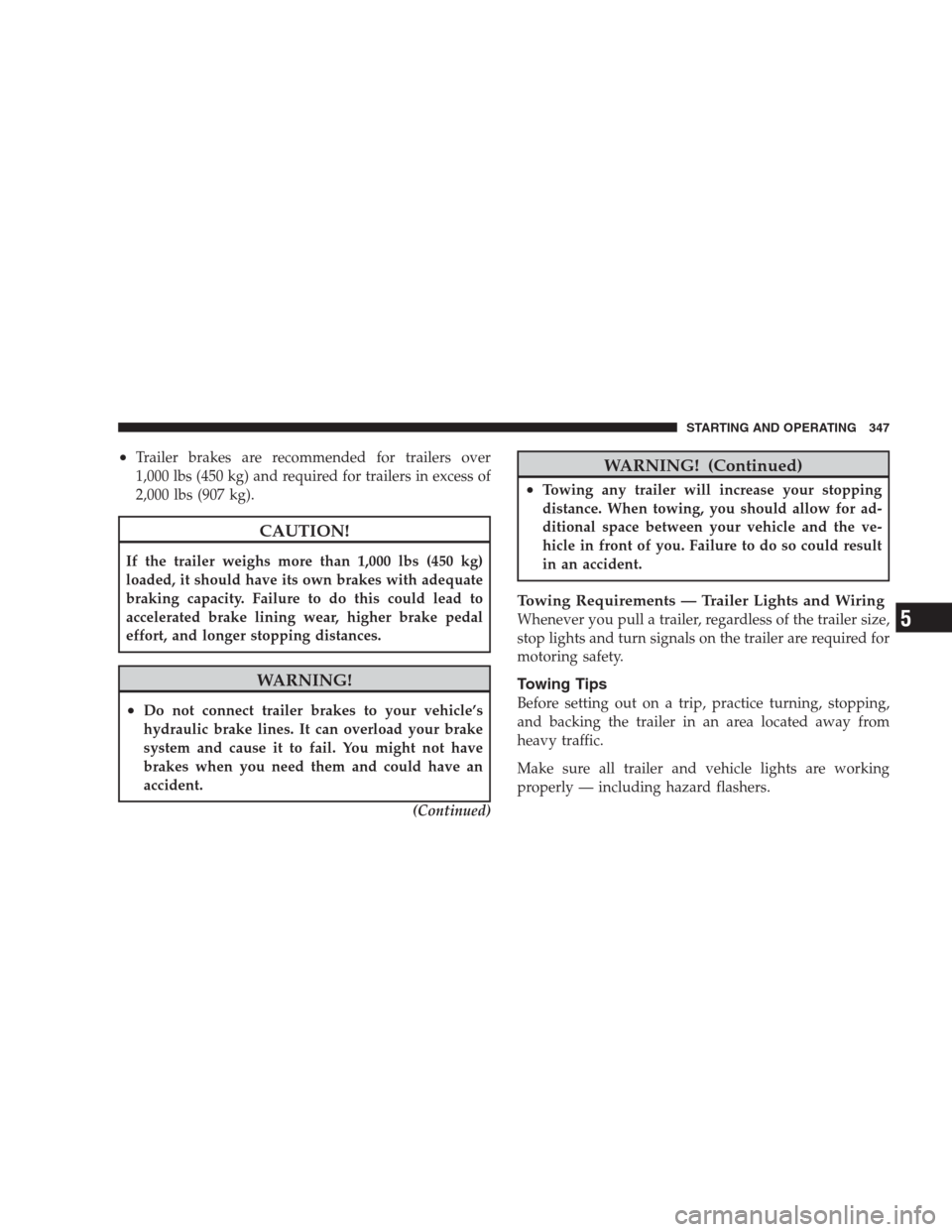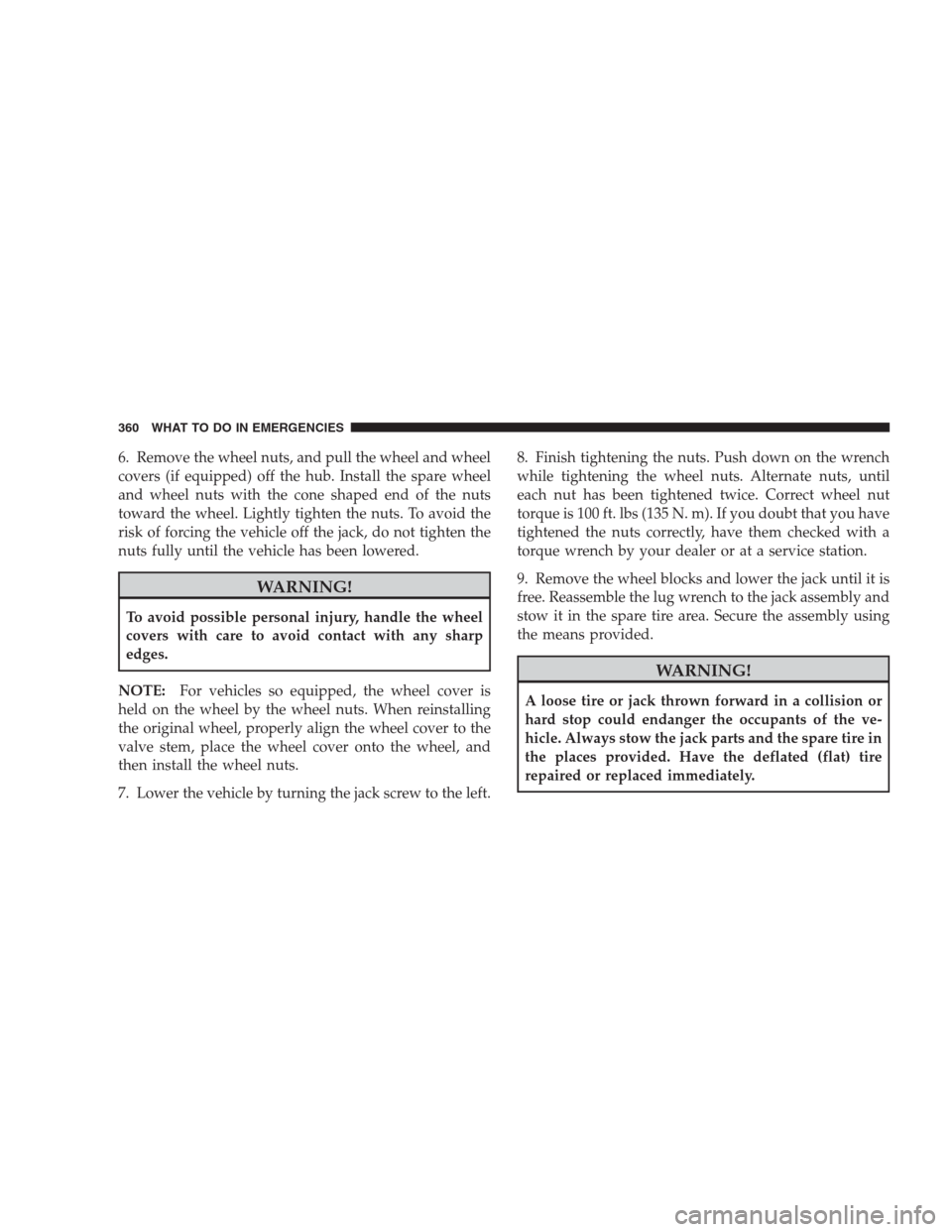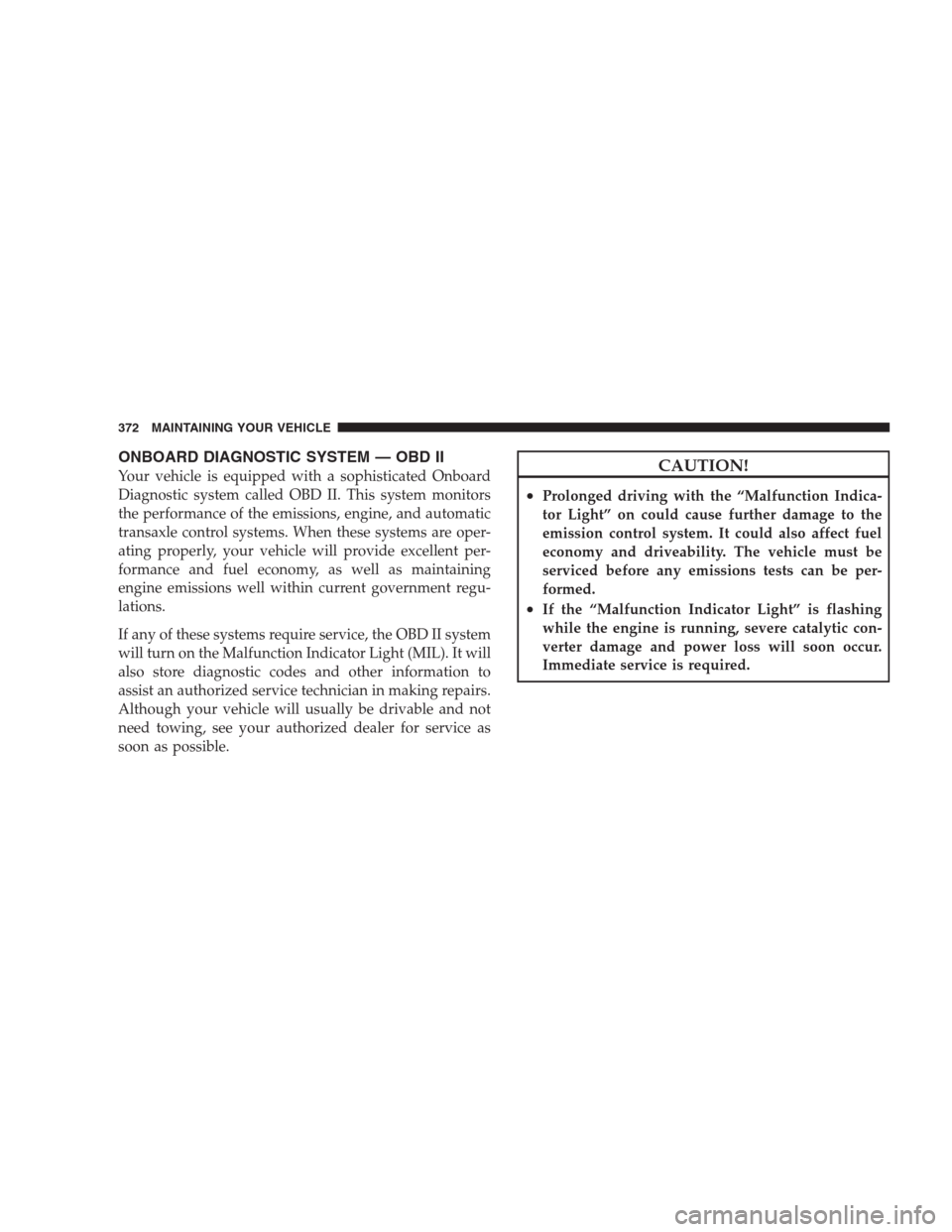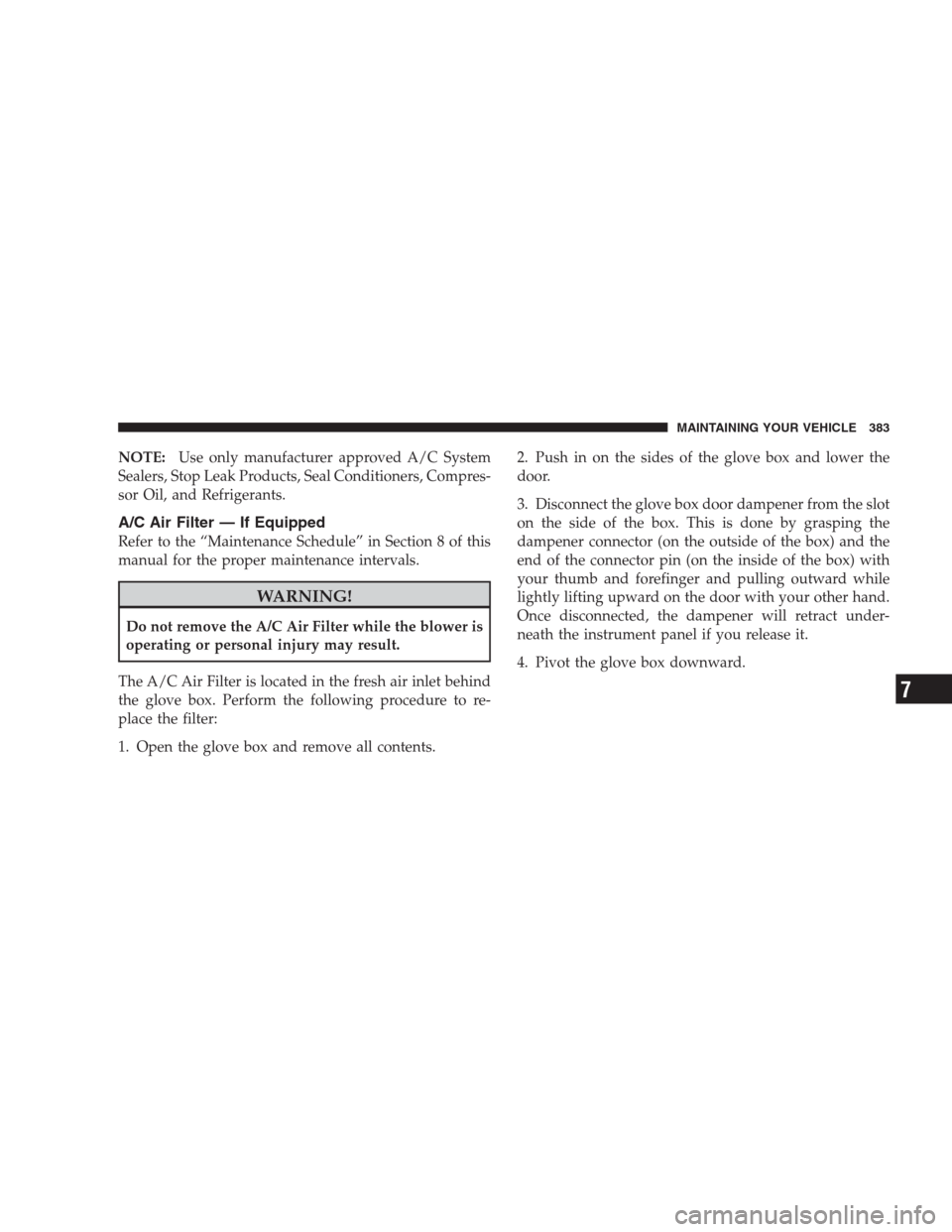Page 349 of 475

•Trailer brakes are recommended for trailers over
1,000 lbs (450 kg) and required for trailers in excess of
2,000 lbs (907 kg).
CAUTION!
If the trailer weighs more than 1,000 lbs (450 kg)
loaded, it should have its own brakes with adequate
braking capacity. Failure to do this could lead to
accelerated brake lining wear, higher brake pedal
effort, and longer stopping distances.
WARNING!
•Do not connect trailer brakes to your vehicle’s
hydraulic brake lines. It can overload your brake
system and cause it to fail. You might not have
brakes when you need them and could have an
accident.
(Continued)
WARNING! (Continued)
•Towing any trailer will increase your stopping
distance. When towing, you should allow for ad-
ditional space between your vehicle and the ve-
hicle in front of you. Failure to do so could result
in an accident.
Towing Requirements — Trailer Lights and Wiring
Whenever you pull a trailer, regardless of the trailer size,
stop lights and turn signals on the trailer are required for
motoring safety.
Towing Tips
Before setting out on a trip, practice turning, stopping,
and backing the trailer in an area located away from
heavy traffic.
Make sure all trailer and vehicle lights are working
properly — including hazard flashers.
STARTING AND OPERATING 347
5
Page 350 of 475

Automatic Transaxle
The DRIVE range can be selected when towing. How-
ever, if frequent shifting occurs while in this range, third
gear for a four-speed automatic and the fifth gear for a
six-speed AutoStick�should be selected.
NOTE:Using third or fifth instead of DRIVE while
operating the vehicle under heavy operating conditions,
will improve performance and extend transaxle life by
reducing excessive shifting and heat build-up. This ac-
tion will also provide better engine braking.
If youREGULARLY TOWa trailer for more than 45 min-
utes of continuous operation, then change the automatic
transaxle fluid and filter according to the interval speci-
fied for “police, taxi, fleet, or frequent trailer towing” in
the “Maintenance Schedule” in this manual.NOTE:Check the four-speed automatic transaxle fluid
level before towing. AutoStick�six—speed transmission
is sealed and the fluid level cannot be checked. See your
authorized dealership service center for assistance.
Electronic Speed Control — (If Equipped)
•
Do not use in hilly terrain or with heavy loads.
•When using the speed control, if you experience speed
drops greater than 10 mph (16 km/h), disengage until
you can get back to cruising speed.
•Use speed control in flat terrain and with light loads to
maximize fuel efficiency.
348 STARTING AND OPERATING
Page 362 of 475

6. Remove the wheel nuts, and pull the wheel and wheel
covers (if equipped) off the hub. Install the spare wheel
and wheel nuts with the cone shaped end of the nuts
toward the wheel. Lightly tighten the nuts. To avoid the
risk of forcing the vehicle off the jack, do not tighten the
nuts fully until the vehicle has been lowered.
WARNING!
To avoid possible personal injury, handle the wheel
covers with care to avoid contact with any sharp
edges.
NOTE:For vehicles so equipped, the wheel cover is
held on the wheel by the wheel nuts. When reinstalling
the original wheel, properly align the wheel cover to the
valve stem, place the wheel cover onto the wheel, and
then install the wheel nuts.
7. Lower the vehicle by turning the jack screw to the left.8. Finish tightening the nuts. Push down on the wrench
while tightening the wheel nuts. Alternate nuts, until
each nut has been tightened twice. Correct wheel nut
torque is 100 ft. lbs (135 N. m). If you doubt that you have
tightened the nuts correctly, have them checked with a
torque wrench by your dealer or at a service station.
9. Remove the wheel blocks and lower the jack until it is
free. Reassemble the lug wrench to the jack assembly and
stow it in the spare tire area. Secure the assembly using
the means provided.
WARNING!
A loose tire or jack thrown forward in a collision or
hard stop could endanger the occupants of the ve-
hicle. Always stow the jack parts and the spare tire in
the places provided. Have the deflated (flat) tire
repaired or replaced immediately.
360 WHAT TO DO IN EMERGENCIES
Page 363 of 475

10. Place the deflated (flat) tire in the cargo area,have the
tire repaired or replaced as soon as possible.
11. Check the spare tire pressure as soon as possible.
Correct pressure as required.
JUMP-STARTING PROCEDURE
The battery is stored between the left front headlight
assembly and the left front wheel splash shield. Access is
through the splash shield.
Jump-starting remote battery terminals are located under
the hood.
WARNING!
•Take care to avoid the radiator cooling fan when-
ever the hood is raised. It can start anytime the
ignition switch is on. You can be hurt by the fan.
(Continued)
WARNING! (Continued)
•Do not attempt to push or tow your vehicle to get
it started. Vehicles equipped with an automatic
transaxle cannot be started this way. Unburned
fuel could enter the catalytic converter and once
the engine has started, ignite and damage the
converter and vehicle. If the vehicle has a dis-
charged battery, booster cables may be used to
obtain a start from another vehicle. This type of
start can be dangerous if done improperly, so
follow this procedure carefully.
•Do not use a booster battery or any other booster
source with an output that exceeds 12-Volts.
1. Wear eye protection and remove any metal jewelry
such as watchbands or bracelets that might make an
inadvertent electrical contact.
WHAT TO DO IN EMERGENCIES 361
6
Page 370 of 475

▫Windshield Washers.................. 385
▫Exhaust System..................... 386
▫Cooling System..................... 388
▫Brake System....................... 394
▫Automatic Transaxle.................. 395
▫Appearance Care And Protection From
Corrosion.......................... 398
▫Cleaning Center Console Cupholders...... 403
▫Convertible Top Care................. 403
▫Weather Strip Care — Soft & Hard Top..... 405
�Fuses.............................. 405
▫Totally Integrated Power Module (TIPM) . . . 405
�Vehicle Storage....................... 411�Replacement Bulbs.................... 411
�Bulb Replacement..................... 412
▫Headlight.......................... 412
▫Front Turn Signal/Parking Light......... 414
▫Front Fog Light..................... 414
▫Tail/Stop, Rear Turn Signal And Backup
Lights............................ 416
▫License Plate Light................... 418
▫Center High-Mounted Stop Light (CHMSL) . . 419
�Fluids And Capacities.................. 420
�Fluids, Lubricants, And Genuine Parts....... 421
▫Engine............................ 421
368 MAINTAINING YOUR VEHICLE
Page 374 of 475

ONBOARD DIAGNOSTIC SYSTEM — OBD II
Your vehicle is equipped with a sophisticated Onboard
Diagnostic system called OBD II. This system monitors
the performance of the emissions, engine, and automatic
transaxle control systems. When these systems are oper-
ating properly, your vehicle will provide excellent per-
formance and fuel economy, as well as maintaining
engine emissions well within current government regu-
lations.
If any of these systems require service, the OBD II system
will turn on the Malfunction Indicator Light (MIL). It will
also store diagnostic codes and other information to
assist an authorized service technician in making repairs.
Although your vehicle will usually be drivable and not
need towing, see your authorized dealer for service as
soon as possible.CAUTION!
•Prolonged driving with the “Malfunction Indica-
tor Light” on could cause further damage to the
emission control system. It could also affect fuel
economy and driveability. The vehicle must be
serviced before any emissions tests can be per-
formed.
•If the “Malfunction Indicator Light” is flashing
while the engine is running, severe catalytic con-
verter damage and power loss will soon occur.
Immediate service is required.
372 MAINTAINING YOUR VEHICLE
Page 375 of 475

Loose Fuel Filler Cap Message
After fuel is added, the vehicle diagnostic system can
determine if the fuel filler cap is possibly loose or
improperly installed. A “GASCAP” message will be
displayed in the instrument cluster. Tighten the gas cap
until a�clicking�sound is heard. This is an indication that
the gas cap is properly tightened. Press the trip odometer
“Reset” button to turn off the message. If the problem
persists, the message will appear the next time the
vehicle is started. This might indicate a damaged cap. If
the problem is detected twice in a row, the system will
turn on the “Malfunction Indicator Light (MIL).” Resolv-
ing the problem will turn the MIL light off.
EMISSIONS INSPECTION AND MAINTENANCE
PROGRAMS
In some localities, it may be a legal requirement to pass
an inspection of your vehicle’s emissions control system.
Failure to pass could prevent vehicle registration.
For states that require an Inspection and Mainte-
nance (I/M), this check verifies the Malfunction
Indicator Light (MIL) is functioning and is not on
when the engine is running, and that the OBD II system
is ready for testing.
Normally, the OBD II system will be ready. The OBD II
system maynotbe ready if your vehicle was recently
serviced, recently had a dead battery or a battery replace-
ment. If the OBD II system should be determined not
ready for the I/M test, your vehicle may fail the test.
MAINTAINING YOUR VEHICLE 373
7
Page 385 of 475

NOTE:Use only manufacturer approved A/C System
Sealers, Stop Leak Products, Seal Conditioners, Compres-
sor Oil, and Refrigerants.
A/C Air Filter — If Equipped
Refer to the “Maintenance Schedule” in Section 8 of this
manual for the proper maintenance intervals.
WARNING!
Do not remove the A/C Air Filter while the blower is
operating or personal injury may result.
The A/C Air Filter is located in the fresh air inlet behind
the glove box. Perform the following procedure to re-
place the filter:
1. Open the glove box and remove all contents.2. Push in on the sides of the glove box and lower the
door.
3. Disconnect the glove box door dampener from the slot
on the side of the box. This is done by grasping the
dampener connector (on the outside of the box) and the
end of the connector pin (on the inside of the box) with
your thumb and forefinger and pulling outward while
lightly lifting upward on the door with your other hand.
Once disconnected, the dampener will retract under-
neath the instrument panel if you release it.
4. Pivot the glove box downward.
MAINTAINING YOUR VEHICLE 383
7